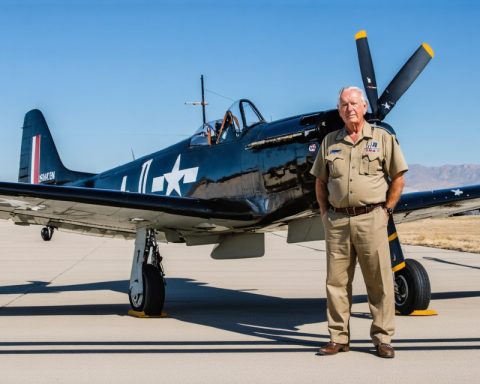- A routine Delta flight nearly encountered U.S. Air Force jets during takeoff from Ronald Reagan National Airport, prompting emergency maneuvers.
- The plane’s collision-alert system activated, guiding pilots to adjust their trajectory safely away from the military aircraft.
- Air traffic controllers quickly restored order, ensuring the safety of both civilian and military crafts.
- This incident raises ongoing concerns about military and civilian flight proximity, recalling a past tragic collision.
- Data shows over 15,000 similar close-call incidents near Reagan National Airport from 2021 to 2024.
- The FAA has implemented measures, requiring aircraft to broadcast positions for enhanced air traffic safety.
- This event highlights the imperative role of technology and vigilance in maintaining aviation safety in crowded airspaces.
A routine takeoff from Washington’s bustling Ronald Reagan National Airport veered towards dangerous territory one recent Friday afternoon. The clock had just struck 3:15 when Delta Flight 2983 angled into the skies, its engines humming with purpose. Unbeknownst to its passengers, the flight was about to brush against shadows of military might—the sleek forms of four U.S. Air Force T-38 Talon jets, gliding towards a ceremonial rendezvous at Arlington National Cemetery.
Caught in this sudden aerial ballet, the Delta crew was jolted by the urgent clamor of the onboard collision-alert system. Like a sentinel awakening from a deep slumber, it announced the uncomfortably close presence of the military jets. This high-tech guardian, equipped to ward off midair calamities, instructed the pilots to deftly alter their trajectory, climbing while their silent adversaries descended.
Within moments, seasoned air traffic controllers intercepted the unfolding drama from the ground. They swiftly directed both civilian and military crafts to safer paths, restoring order to the skies above Washington. As calmness resumed, Flight 2983 continued serenely to Minneapolis, its passengers blissfully unaware of the close encounter.
Although this incident concluded with everyone unharmed, it echoes a growing chorus of concern. Just a heartbeat ago, a tragic collision between an American Airlines flight and an Army Black Hawk helicopter claimed 67 lives, freshening worries about military-civilian flight proximity. These recent tales of near-misses expose intricate layers of accountability, prompting Congress and administrative bodies to scrutinize military maneuvers amidst civilian airspace.
Experts note an unsettling pattern; data reveals over 15,000 instances from 2021 to 2024 where such close calls threatened Reagan National Airport’s traffic. In response, the FAA has mandated aircraft to broadcast their positions, ensuring real-time awareness for air traffic controllers tasked with managing an increasingly crowded sky.
In a world where human vigilance pairs with technological intelligence, the sky’s vastness can sometimes mask looming threats. Yet, with the right systems in place, harrowing scenarios can transform into tales of adept handling and close escapes—reminding us all that, in the realm of aviation, safety is more than a protocol; it’s a dynamic dance guided by a blend of precision, foresight, and cutting-edge technology.
Sky High Drama: Navigating Air Traffic Encounters Safely
Overview of Recent Incident
A close encounter in the skies over Washington, involving Delta Flight 2983 and four U.S. Air Force T-38 Talon jets, highlighted the complexities and potential dangers of operating within busy airspaces. The swift response from onboard collision-alert systems and skilled air traffic controllers ensured that the flight proceeded safely to its destination in Minneapolis. However, this event underscores ongoing concerns about airspace safety and the proximity of civilian and military flights.
Additional Facts and Analysis
– Frequency of Incidents: Over 15,000 close calls were reported around Reagan National Airport between 2021 and 2024. This statistic underlines the challenges in managing air traffic within such congested areas.
– Technology in Aviation Safety: Collision-alert systems, such as the Traffic Collision Avoidance System (TCAS), play a crucial role in preventing midair collisions. These systems detect nearby aircraft and suggest evasive maneuvers to the pilots.
– Integration of Military and Civilian Air Traffic: The integration of military flight operations within civilian airspace, especially near major airports, has increased the need for sophisticated coordination efforts.
How Air Traffic Controllers Enhance Safety
Air traffic controllers manage airspace to prevent collisions, ensuring aircraft maintain safe distances. They coordinate with both civilian and military jets, providing real-time instructions to adjust routes and altitudes as necessary.
Market Forecasts & Industry Trends
– Growth in Air Traffic: The aviation industry anticipates continued growth in air traffic, projected by the International Air Transport Association (IATA) to double over the next 20 years. This growth necessitates advancements in air traffic management technologies.
– Investment in Aviation Technology: There is increasing investment in technologies like ADS-B (Automatic Dependent Surveillance–Broadcast) to improve aircraft tracking in real-time. This technology is now mandatory for most aircraft operating in controlled airspace.
Pros & Cons Overview
Pros
– Improved Safety: Collision-alert systems and skilled air traffic control improve overall flight safety.
– Technological Advancements: Constant upgrades in aviation technology enhance detection and response capabilities.
Cons
– Risk of Human Error: Despite advanced systems, human error remains a factor in managing airspace safety.
– Complexity of System Integration: Integrating new technologies with existing systems poses logistical challenges.
Actionable Recommendations
1. Stay Informed: Airlines and travelers should remain informed about advancements in aviation technology and safety protocols.
2. Advocate for Continued Investment: Support initiatives that fund research and development of aviation safety technologies.
3. Regular Training: Ensure air traffic controllers and pilots receive regular training on new systems and procedures to handle potential emergencies effectively.
Conclusion
Navigating busy airspaces safely requires constant vigilance, state-of-the-art technology, and seamless coordination between civilian and military operations. As air travel continues to grow, so too must our commitment to advancing safety measures. By fostering an environment of continuous improvement and investment in technology, the aviation industry can mitigate risks and maintain the safest skies possible.
For more information on aviation safety, visit the Federal Aviation Administration (FAA).








